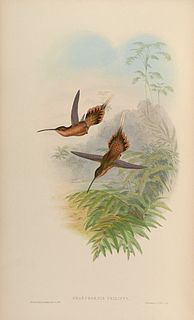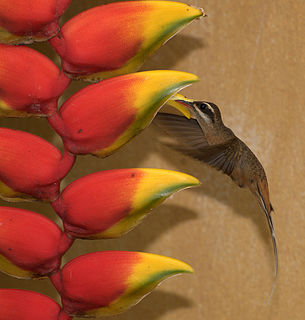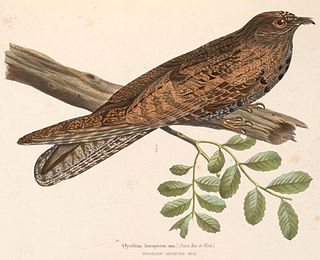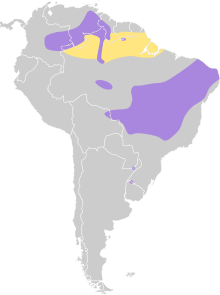
The sooty-capped hermit is a species of bird in the family Trochilidae, the hummingbirds. It is found in Brazil, Colombia, French Guiana, Guyana, Suriname, and Venezuela.

The straight-billed hermit is a species of bird in the family Trochilidae, the hummingbirds. It is found in Brazil, Colombia, Ecuador, French Guiana, Guyana, Peru, Suriname, and Venezuela.

The needle-billed hermit is a species of hummingbird in the family Trochilidae. It is found in Bolivia, Brazil, and Peru.

The green-tailed goldenthroat is a species of hummingbird in the subfamily Polytminae, the mangoes. It is found in Bolivia, Brazil, Colombia, French Guiana, Guyana, Peru, Suriname, and Venezuela, and possibly Ecuador.

The razor-billed curassow is a species of bird in the family Cracidae, the chachalacas, guans, and curassows. It is found in Bolivia, Brazil, Colombia, and Peru.

The speckled chachalaca is a species of bird in the family Cracidae, the chachalacas, guans, and curassows. It is found in Bolivia, Brazil, Colombia, Ecuador, and Peru.

The black-fronted nunbird is a species of near-passerine bird in the family Bucconidae, the puffbirds, nunlets, and nunbirds. It is found in Bolivia, Brazil, Colombia, Ecuador, and Peru.

The spot-tailed nightjar is a species of nightjar in the family Caprimulgidae. It is found in Honduras, Mexico, Nicaragua, and every mainland South American country except Chile and Uruguay.

The blackish nightjar is a species of bird in the family Caprimulgidae. It is found in Brazil, Bolivia, Colombia, Ecuador, French Guiana, Guyana, Peru, Suriname, and Venezuela.

The sand-colored nighthawk is a species of nightjar in the family Caprimulgidae. It is found in Bolivia, Brazil, Colombia, Ecuador, Peru, and Venezuela.

The sickle-winged nightjar is a species of nightjar in the family Caprimulgidae. It is found in Argentina, Brazil, Paraguay and possibly Uruguay.

The rufous-bellied nighthawk is a species of nightjar in the family Caprimulgidae. It is found in Bolivia, Colombia, Ecuador, Peru, and Venezuela.

The short-tailed nighthawk is a species of nightjar in the family Caprimulgidae. It is found in Mexico, in every Central American country except El Salvador, in Trinidad and Tobago, and in every mainland South American country except Chile and Uruguay.

The long-trained nightjar is a species of nightjar in the family Caprimulgidae. It is found in Argentina and Brazil.

The planalto hermit is a species of bird in the family Trochilidae, the hummingbirds. It is found in Argentina, Bolivia, Brazil, Paraguay, and Peru.

The long-tailed potoo is a species of bird in the family Nyctibiidae. It is found in every mainland South American country except Chile and Uruguay.

The white-winged potoo is a species of bird in the family Nyctibiidae. It is found in Brazil, French Guiana, Guyana, Peru, Suriname, and Venezuela.

The blue-crowned trogon is a species of bird in the family Trogonidae, the quetzals and trogons. It is found in Argentina, Bolivia, Brazil, Colombia, Ecuador, Paraguay, and Peru.

The Amazonian trogon, is a near passerine bird in the family Trogonidae, the trogons and quetzals. It is found in Bolivia, Brazil, Colombia, Ecuador, Peru, and Venezuela.

The butterfly coquette is a species of hummingbird in the "coquettes", tribe Lesbiini of subfamily Lesbiinae. It is found in Bolivia, Brazil, Colombia, Ecuador, Peru, and Venezuela.























